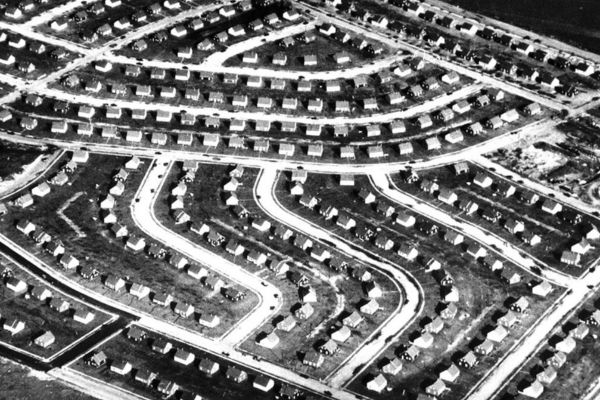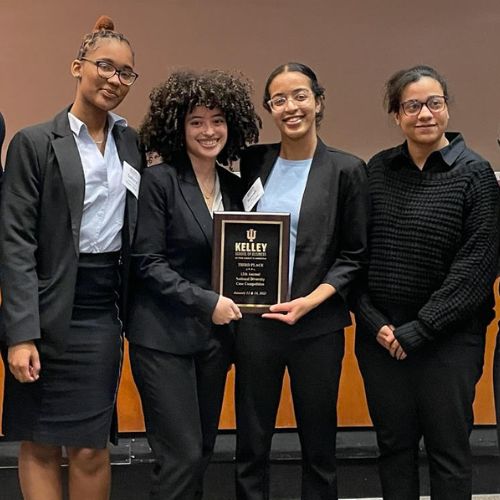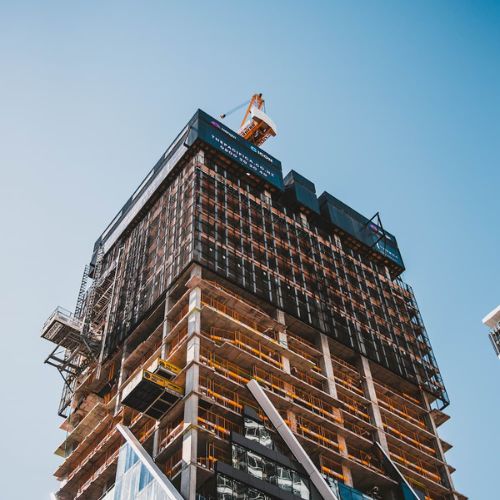The title of the event held in Corcoran Commons on Nov. 15 was “Promoting Racial Justice in Housing,” but it might just as well have been—“Why You Should Rethink All Your Assumptions About the U.S. Housing System.”
RELATED
Promoting Racial Justice in Housing
About 150 people, mostly students, took their seats in The Heights Room in the Commons that evening for a debunking two hours of conversation featuring four prominent experts on the topic. The Boston College Forum on Racial Justice in America sponsored the event together with the Joseph E. Corcoran Center for Real Estate and Urban Action.
One by one, the panelists chipped away at such notions that federal aid for housing goes mostly to the people who need it, and that racial inequity is primarily a sidelight in the checkered history and ongoing saga of U.S. housing policy. They also broached ways of undoing a stubborn legacy that included such barriers as property deeds that prohibited home sales to Blacks, contributing to today’s racial wealth gap.

Boston College Law Professor and Faculty Fellow Lisa T. Alexander
“Racism is so attached to housing and home value that you can’t understand housing markets unless you put this front and center,” said Boston College Law Professor and Faculty Fellow Lisa T. Alexander. “People aren’t intentionally trying to be racist,” she added, stressing that the inequities reside mainly in the structure of the housing system at both the national and local levels.
The forum dealt mainly with different elements of that structure, directly and indirectly affecting people of color. For example, according to the speakers, the main recipients of federal housing largesse are not the low-income people who qualify for mean-tested aid. It is the well-off, who get the lion’s share of help through the federal mortgage interest tax deduction.
“That’s the biggest subsidy we provide,” Alexander said in response to a question by Dean Gregory Kalscheur, S.J., of the Morrissey College of Arts and Sciences, about the “American dream” of homeownership. Father Kalscheur moderated the forum together with Joy Moore, vice president and executive director of Boston College’s Pine Manor Institute for Student Success. Both are co-moderators of the Boston College Forum on Racial Justice in America.
Alexander and other panelists also underscored the continuing fallout from past discrimination in housing. They pointed to numerous studies indicating that today’s racial wealth gap in the United States owes heavily to the fact that Black Americans in particular were frozen out of the federal mortgage finance system, notably during the post-World War II housing boom. Nonwhites were often simply barred from purchasing homes or obtaining federally subsidized mortgage loans that allowed their white counterparts to build wealth over generations.
Today, state and local government housing policies often continue to disadvantage people of color who make up the greater share of low-income urban dwellers, said Jeanne Pinado, executive vice president of investment management company Colliers International and board chair of MassHousing, a quasi-public agency in Massachusetts that provides financing for affordable housing development.
“ Racism is so attached to housing and home value that you can’t understand housing markets unless you put this front and center. ”
Pinado cited Boston’s Seaport district, rebuilt over the past couple decades—on land formerly owned by the state. “All of it went to developers who built luxury housing,” she said, adding that the City of Boston furthered this development through zoning rules favoring luxury towers. Pinado did note that the city, as “an afterthought,” has now set aside a plot of land for affordable housing in the Seaport.
“Those are recent government housing policies. It’s not ancient history,” Pinado said of the slant toward high-end development.
As evidence of current discrimination by realtors and others, she related that federal enforcers of fair-housing laws have for decades sent out pairs of nonwhite “testers” who pretend they are seeking to rent an apartment or purchase a home. Those testers are still more likely to have their applications denied or otherwise face obstacles than white applicants with the same qualifications, according to regulators and housing advocates.
Other panelists included Chrystal Kornegay, executive director of MassHousing, and Juana B. Matias, regional director of the U.S. Department of Housing and Urban Development, or HUD. The format was geared to back-and-forth conversation rather than formal presentations, with the panelists seated on an elevated platform bookended by the two moderators who posed questions to them.
History was present throughout the discussion. Panelists spoke, for example, about the origins of federal housing support during the Great Depression, when the government first began subsidizing home ownership with mortgage insurance—excluding Black citizens. “It was a completely racialized system,” said Alexander.

Aerial view of Levittown, Long Island shortly after construction in 1948
The Case of the Property Deeds
The forum also threw light on government practices such as demolishing homes and neighborhoods to make way for highways to burgeoning suburbs during the postwar period. Those policies almost exclusively aided white suburbanites while tamping down home values for disproportionately nonwhite urbanites left behind, according to the speakers.
And then there were the so-called “racial covenants” inserted into property deeds, expressly prohibiting the sale (or renting) of homes to African Americans. These became a stipulation of loans backed by the Federal Housing Administration, or FHA, shaping development in boomtowns such as Levittown, Long Island. Technically, the clauses still exist in deeds across the country, though federal law makes such discrimination illegal, Matias of HUD pointed out.
When Father Kalscheur asked how to narrow the racial housing gap, panelists answered that the remedies are simple in theory, if politically unpopular among the majority.
“If we want to solve the problem, we have to take people who were denied opportunities in the past, and give them opportunities to own homes,” Alexander said, drawing a round of applause. By extension, that would mean providing aid consciously and pointedly to nonwhite citizens. Kornegay said, “We could do that. It’s not that hard.”
“ Those are recent government housing policies. It’s not ancient history. ”
For example, state agencies can set ambitious goals and targets for the percentage of their mortgage loans that go specifically to nonwhite homebuyers, as MassHousing has recently done (setting that goal at 50 percent). Another idea floated at the forum was for the government to provide direct compensation or mortgage assistance to people of color who live in areas where those racially restrictive deeds once prevented home sales to nonwhite families.
In the audience, students asked how they could help tackle these problems. Kornegay suggested they bring a bunch of friends to community meetings where committees, for instance, take up the question of zoning policies that restrict the supply of affordable, multifamily housing.
“You have to be there to experience it and watch it,” she said of a local decision-making process that often keeps “those people”—lower income and nonwhite—out of the community. “It’s a contact sport.”





